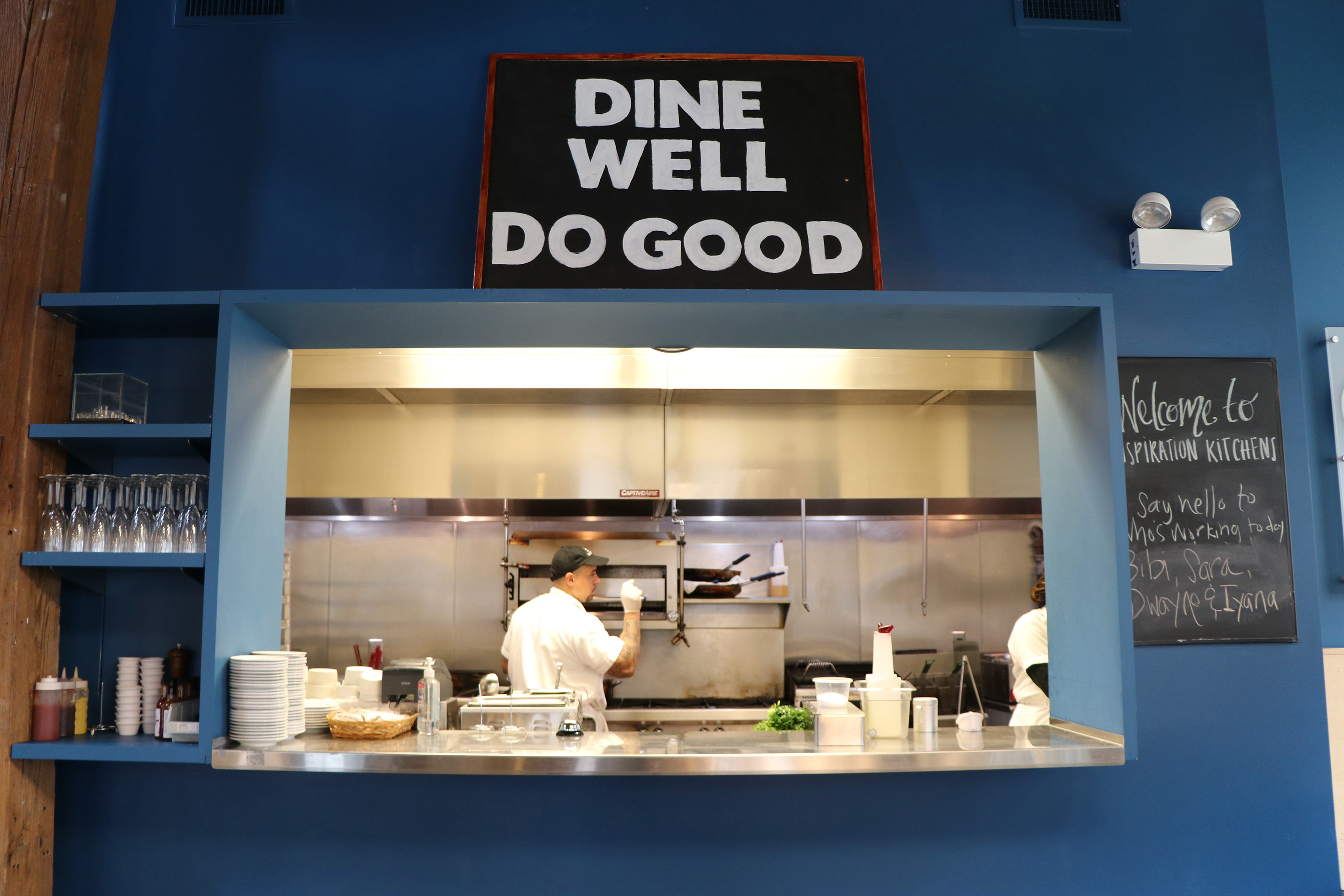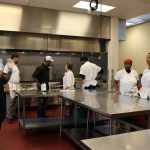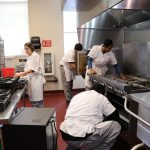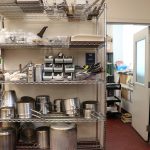By Lily Qi
Medill Reports
About 10 freshmen gathered at the back of the kitchen. It’s their first day here and they have no idea what is coming in the following 12 weeks. Most of them aren’t sure what is going to happen in the next few hours. This occurs every four months at the Inspiration Kitchen in East Garfield Park because but not many kitchens operate like this.

It’s Friday morning inside the Inspiration Kitchen where Samara Hightower and Antwain Lee are busy assigning first-day students – some of them homeless – tasks necessary to clean the kitchen. More advanced students are cooking.
“We make sure at the end of the day they actually obtain the skills and teach them how to be self-efficient, how to work properly and keep themselves safe,” Lee said.
For nearly two decades, Inspiration Kitchen has been offering free job training for those who are interested in cooking. It started with an idea brought by one of the board members back to late 1990s when the organization was only a soup kitchen.
“One of the board members realized that we had a lot of people coming in [for] the free meals and were hanging out in the space during the day and they didn’t have jobs,” said Evan Cauble-Johnson, chief development officer at Inspiration Kitchen. “So he thought: What if we invited them to come back in the kitchen over the lunch hour when we were serving and start to [teach] basic skills.”
The idea officially became a program in 2001 with many Chicago chefs helped design the curriculum. In 2005, the restaurant for paying public, Inspiration Kitchen, opened in uptown and moved to the current location at East Garfield Park in 2011.
On the front line, a window block gives customers a glance of what is going on in the kitchen as advanced students prepare lunch. Lyanna is chopping onions, tomatoes and chilis while Elio is deftly pressuring burger patty. Some of these students knew nothing about cooking just six weeks ago.
Students at the program came with various backgrounds, some of them had low-paying jobs, some are unemployed, homeless or have criminal backgrounds. Unlike other job training programs, passing a simple reading and math test is the only requirement for enrollment.
“One thing that’s interesting about our program and the kind of the niche that we try to occupy is we really want to be there for people who might not be qualified to enter other programs,” said Cauble-Johnson.
The training includes three stages and students work from levels one to three before graduating from program. At block one, they will learn basics such as making stocks and sauce, then move to block two where they will be filling catering orders. Finally, at block three, students will cook on the line for real customers at the Inspiration Kitchen. Specialties of the house include traditional American dishes such as salads, sandwiches and burgers, but also original dishes like Shrimp Po’ Boy and Shrimp & Grits, they both are cooked with shrimps but in different styles. Korean and Mexican cuisines are served at the restaurant as well.

“I see a participant start in their first month and then when they graduate in their third month, I see their skill set in the kitchen has evolved and most of the participants are just much more confident,” said Elizabeth Holland, chef trainer at the Inspiration Kitchen. “They tend to be a little bit more stable towards the end and they’re optimistic about finding jobs.”
Elio Lopez, who works on the line now, heard about the program through his probation officer. He believes the program would get him prepared for jobs at a real kitchen.
“I found the love in prison of cooking and heard about this program and I proceeded to become a chef,” said Lopez, who wants to work as a system food handler after graduation. “With a lot of training, you learn a lot of different techniques. They show you how to cook for the restaurant and get your ready for the real world.”

According to Caudle-Johnson, many graduates from Inspiration Kitchen get a job at fine dining establishments in the city while others work in catering for large institutions like Sodexo or institutional cafeterias at hospitals and schools.
“Usually on average about a hundred people enroll in the program and about 60 percent of them graduates,” said Caudle-Johnson. “We have a pretty high drop-off rate, I think that’s really due to not having entry level requirements and having a very open-door policy.”

In 2016, the food insecure population in Cook County was more than 600,000 people, according to statistics showed on Feeding America annual map. Unemployed and low-income working families are among the most venerable groups for food insecurity.

Traditionally, food pantries and soup kitchens offering free meals are at the core of tackling food insecurity. However, organizations came to realize that teaching someone to fish is better than giving just one fish. Helping those who have suffered to learn how to support themselves has become a shift.
“We have the core of what we do is we distribute food to a network of more than 700 partner agencies in Cook County,” said Greg Trotter, a spokesman for the Greater Chicago Food Depository, one of the leading charities in Chicago. “The needs had changed too over the years and so our response has beyond just like the traditional food bank distributes food to the food pantry model.”
Programs today at various agencies are also aimed for providing specified job trainings to different groups. For example, the Chicago Lighthouse offers job training program for who are blind or visually impaired to work as call centers support, front desk assistance, data entry and related fields. The Greater Chicago Food Depository also has its own Chicago Community Kitchen program.
Why cooking? Holland, a former sous chef at a Michelin restaurant, explained that a shortage of prep cooks in kitchens, especially fine diners, makes cook training program a perfect fit for the market.
“There’s always like a shortage of prep cooks in kitchens so you always hear chefs talking about we need more bodies here and I think this (program) is a really great answer to the problem of cook shortages in the kitchens, helping people who are actively seeking employment and training them in the kitchen,” she said.
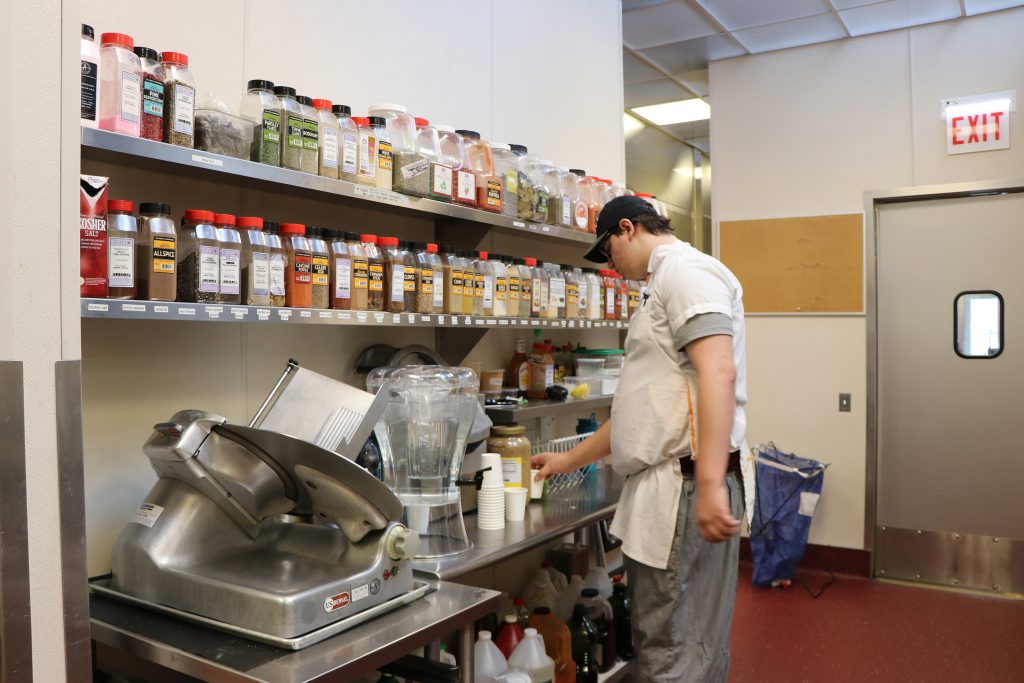
These programs also provide opportunities for those who like Lyanna Simmons, who used to be masseuse but dreams of becoming a chef.
“I never worked in a kitchen before and I’m looking to open up a cafe,” said Simmons, who is on her ninth week of training. “I wanted to get more experience in the kitchen and what the kitchen consists of and customers and how fast-paced that would be.”
She is moving to Las Vegas this summer and considering a job at a daycare. Graduation is the first step towards her ultimate goal of opening her own café.
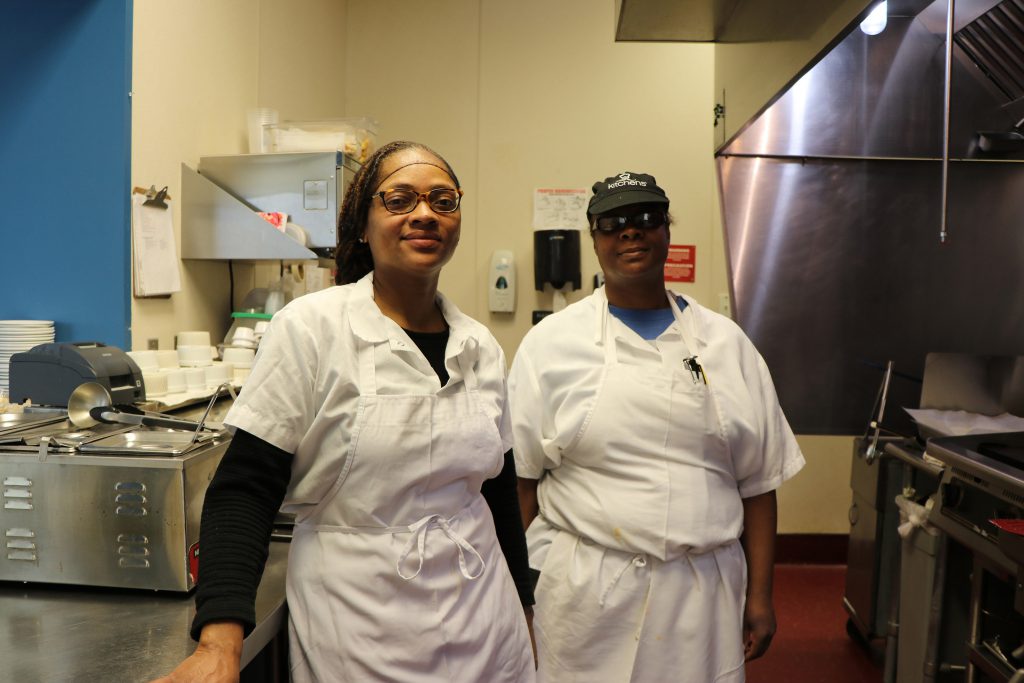
Many students in the Inspiration Kitchen program have their own career plans. They all acknowledge the program gets them ready for the future, not only on professional side but also working and personal relationships. Apart from skill training, job consulting and career advice are provided as a part of the curriculum.
“It prepares your mind, it prepares you for different people you would have to work with and how to deal with different people and different situation,” said Simmons.
Both Lopez and Simmons are cooking for customers now. As graduation approaching, they can feel themselves moving closer to their dreams.

“Since I was a kid, my mom always said, ‘You want to eat? Come and help me chop up the garlic.’ And I found it from my mother the love of cooking,” said Lopez, his eyes are shining with passion. “My dream is to become a cook.”

